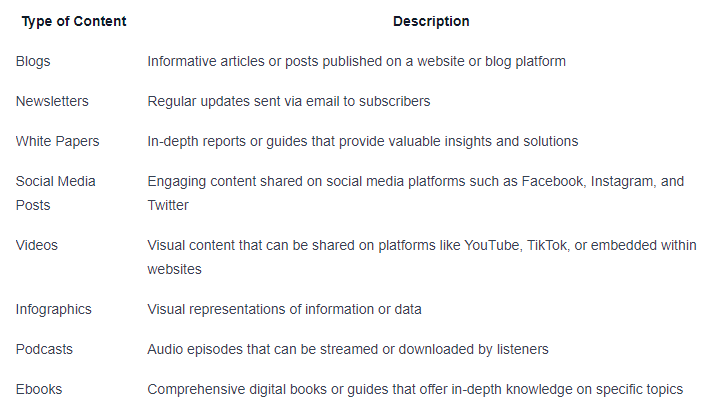To grasp the concept of content marketing, it's essential to explore its definition and understand its importance in the marketing landscape.
Content marketing is a strategic marketing approach focused on creating and distributing valuable, relevant, and consistent content to attract and retain a clearly defined audience, ultimately driving profitable customer action. Unlike traditional advertising, which primarily aims to sell products or services, content marketing places emphasis on providing valuable information, insights, and entertainment to the audience.
According to the Content Marketing Institute, quality content should be integrated into the marketing process and not treated as something separate. It should be seamlessly woven into all forms of marketing, enhancing the overall marketing efforts [1]. By creating and sharing valuable content, businesses can establish themselves as industry authorities, build customer trust, and foster long-term relationships.
Content marketing plays a pivotal role in modern marketing strategies. It goes beyond traditional advertising by focusing on building relationships and providing value to the audience. Here are some key reasons why content marketing is crucial:
Content marketing is not just a passing trend; it is the present and future of marketing. It provides a significant contrast to traditional advertising methods, focusing on building relationships, providing value, and helping customers before attempting to sell. By adopting a strategic content marketing approach, businesses can effectively engage their target audience, drive customer action, and achieve long-term success.

To ensure the success of a content marketing strategy, setting clear and effective goals is crucial. By defining specific objectives, marketers can align their efforts and measure the impact of their content initiatives. In this section, we will explore the concept of SMART goals in content marketing and the benefits of goal setting.
SMART goals are an effective framework for setting goals in content marketing. The acronym stands for Specific, Measurable, Achievable, Relevant, and Time-bound. Let's break down each component:
Goal setting plays a significant role in the success of content marketing strategies. Here are some key benefits:
By setting SMART goals in content marketing, marketers can enhance their chances of success and drive meaningful results. These goals provide clarity, focus, and a framework for measuring progress. Remember, goals should be aligned with the company's objectives and be regularly evaluated and adjusted to ensure ongoing success.

To maximize the effectiveness of content marketing, it is crucial to align content marketing goals with the overall objectives of the business. This strategic alignment ensures that content marketing efforts contribute directly to the success of the business.
Content marketing goals should be closely linked to the company's broader business objectives [2]. This alignment ensures that content marketing efforts are focused and contribute to the overall growth and success of the business.
For example, if a company's objective is to increase sales and lead generation, content marketing goals should also prioritize lead generation or conversions that directly contribute to sales [2]. By aligning content marketing goals with business objectives, companies can ensure that their content marketing strategy is purposeful and impactful.
While content marketing can have multiple objectives beyond just driving sales, such as building brand recognition and customer loyalty (StoryChief), it is important to acknowledge its significant impact on sales and lead generation as well.
Content marketing plays a vital role in attracting and engaging potential customers throughout the sales cycle. By tailoring content for different stages of the sales process, from awareness to consideration and closing, businesses can effectively engage and sell to their target audience [3].
A well-executed content marketing strategy can attract leads, provide valuable information during the research phase, and ultimately lead to sales. By consistently creating clear, actionable, and engaging content, businesses can nurture relationships with their audience, positioning themselves as trusted partners in their customers' success [3].
Aligning content marketing with business objectives ensures that content efforts are not only engaging and informative but also contribute to revenue generation. By focusing on lead generation, conversions, and sales, businesses can leverage content marketing to directly impact new customer revenue, especially during periods of increased visibility or demand for their products or services.
When content marketing goals align with the broader business objectives, the impact on sales and lead generation becomes more evident, further emphasizing the value of an effective content marketing strategy.
In conclusion, aligning content marketing goals with business objectives ensures that content efforts are purposeful, impactful, and contribute directly to the success of the business. By focusing on lead generation, conversions, and sales, businesses can leverage content marketing to attract and engage their target audience, ultimately driving revenue growth.
To determine the effectiveness and impact of content marketing efforts, it is essential to measure key metrics and analytics. By analyzing these metrics, businesses can evaluate the success of their content marketing strategies and make informed decisions to improve results.
When measuring content marketing success, it's important to go beyond basic metrics such as traffic, as they only provide a superficial understanding of performance [5]. Instead, focus on metrics that provide insights into the value and engagement your content generates. Here are some key metrics to consider:
Effective measurement of content marketing success requires aligning metrics with the goals and objectives set for your content. It's important to establish specific, measurable, achievable, relevant, and time-bound (SMART) goals that align with your overall content marketing strategy. SMART goals provide clarity and enable you to track progress effectively.
Regularly evaluate your content goals to determine if they are being achieved and if adjustments need to be made. Analyze the metrics mentioned above to gain insights into the effectiveness of your content in meeting these goals. By continuously assessing and refining your content marketing strategy based on these metrics, you can drive better results and optimize your efforts for success.
Remember, measuring content marketing success is an ongoing process. Regularly monitor and analyze the metrics to gain a comprehensive understanding of how your content is performing and make data-driven decisions to improve its impact.
To implement a successful content marketing strategy, it is important to understand the different types of content that can be utilized and the various distribution channels available.
Content marketing involves creating and sharing relevant articles, videos, podcasts, and other media to attract, engage, and retain an audience [3]. By consistently producing valuable and informative content, businesses can establish expertise, promote brand awareness, and nurture relationships with their audience.
Here are some common types of content used in content marketing:

By utilizing a mix of these content types, businesses can cater to different preferences and engage their audience through various channels.
Once content is created, it needs to be effectively distributed to reach the target audience. There are several distribution channels available, and choosing the right ones will depend on the nature of the content and the preferences of the target audience.
Some common distribution channels for content marketing include:
Choosing the right distribution channels will depend on the target audience's preferences and behaviors. It is important to track and analyze the performance of each channel to optimize content distribution efforts.
By leveraging various types of content and utilizing effective distribution channels, businesses can maximize the impact of their content marketing strategy and effectively engage their target audience.
When exploring marketing strategies, it's important to understand the differences between content marketing and traditional advertising. While both approaches aim to reach and engage a target audience, they have distinct characteristics that set them apart.
In traditional advertising, marketers have tight control over the message they want to convey. Whether it's a television commercial, print ad, or sponsored social media post, the message is typically straightforward and focuses on the product or service being sold. The goal is to increase sales by creating brand awareness and generating leads.
On the other hand, content marketing allows for much greater flexibility and creativity in delivering the message. Content marketers create and share valuable, informative, and relevant content in various formats, such as blog posts, infographics, videos, podcasts, and social media posts. The focus is on building a relationship with the target audience by providing content that educates, entertains, or inspires them. The ultimate goal is to build trust and loyalty, leading to increased brand awareness, customer loyalty, and ultimately, sales.
Traditional advertising is typically delivered through paid channels, such as television, radio, print, or online ads. Marketers pay for ad placements to interrupt the target audience's attention and deliver their message. The reach and visibility of traditional advertising depend on the budget allocated to paid media placements.
In contrast, content marketing often relies on owned or earned channels. Owned channels include a company's blog, website, or social media accounts, where marketers have control over the content they publish. Earned channels, on the other hand, include organic reach through shares, mentions, and recommendations from the target audience. Content marketing leverages these channels to distribute valuable content and engage with the audience. This approach can be more cost-effective than traditional advertising since it relies less on paid media and more on building a relationship with the target audience [6].
In today's digital age, many marketers find that a combination of both strategies can be the most effective approach. By using a mix of paid, owned, and earned media, marketers can create a comprehensive marketing strategy that leverages the strengths of both content marketing and traditional advertising to reach and engage their target audience.
Understanding the differences between content marketing and traditional advertising allows marketers to make informed decisions about the most suitable strategies for their goals and target audience. By considering the level of control over the message and the delivery channels, marketers can develop effective marketing campaigns that resonate with their audience and achieve their desired outcomes.
[1]: https://contentmarketinginstitute.com/what-is-content-marketing/
[2]: https://rockcontent.com/blog/content-marketing-goals/
[3]: https://mailchimp.com/marketing-glossary/content-marketing/
[4]: https://storychief.io/blog/content-marketing-objectives-examples
[5]: https://www.linkedin.com/pulse/5-ways-measure-success-your-content-marketing-efforts-
[6]: https://www.linkedin.com/pulse/content-marketing-vs-traditional-advertising-whats-difference/